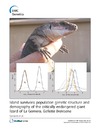Please use this identifier to cite or link to this item:
https://accedacris.ulpgc.es/handle/10553/73179
| Title: | Island survivors: population genetic structure and demography of the critically endangered giant lizard of La Gomera, Gallotia bravoana | Authors: | Gonzalez, Elena G. Ceron-Souza, Ivania Mateo, Jose A. Zardoya, Rafael |
UNESCO Clasification: | 240116 Herpetología | Keywords: | Pairwise Relatedness Estimators Skinks Egernia-Cunninghami Allele Frequency Data Term Sperm Storage Microsatellite Loci, et al |
Issue Date: | 2014 | Journal: | BMC Genetics | Abstract: | Background: The giant lizard of La Gomera (Gallotia bravoana), is an endemic lacertid of this Canary Island that lives confined to a very restricted area of occupancy in a steep cliff, and is catalogued as Critically Endangered by IUCN. We present the first population genetic analysis of the wild population as well as of captive-born individuals (for which paternity data are available) from a recovery center. Current genetic variability, and inferred past demographic changes were determined in order to discern the relative contribution of natural versus human-mediated effects on the observed decline in population size.Results: Genetic analyses indicate that the only known natural population of the species shows low genetic diversity and acts as a single evolutionary unit. Demographic analyses inferred a prolonged decline of the species for at least 230 generations. Depending on the assumed generation time, the onset of the decline was dated between 1200-13000 years ago. Pedigree analyses of captive individuals suggest that reproductive behavior of the giant lizard of La Gomera may include polyandry, multiple paternity and female long-term sperm retention.Conclusions: The current low genetic diversity of G. bravoana is the result of a long-term gradual decline. Because generation time is unknown in this lizard and estimates had large credibility intervals, it is not possible to determine the relative contribution of humans in the collapse of the population. Shorter generation times would favor a stronger influence of human pressure whereas longer generation times would favor a climate-induced origin of the decline. In any case, our analyses show that the wild population has survived for a long period of time with low levels of genetic diversity and a small effective population size. Reproductive behavior may have acted as an important inbreeding avoidance mechanism allowing the species to elude extinction. Overall, our results suggest that the species retains its adaptive potential and could restore its ancient genetic diversity under favorable conditions. Therefore, management of the giant lizard of La Gomera should concentrate efforts on enhancing population growth rates through captive breeding of the species as well as on restoring the carrying capacity of its natural habitat. | URI: | https://accedacris.ulpgc.es/handle/10553/73179 | ISSN: | 1471-2156 | DOI: | 10.1186/s12863-014-0121-8 | Source: | Bmc Genetics [ISSN 1471-2156], v. 15 (121), (Noviembre 2014) |
| Appears in Collections: | Artículos |
Items in accedaCRIS are protected by copyright, with all rights reserved, unless otherwise indicated.
